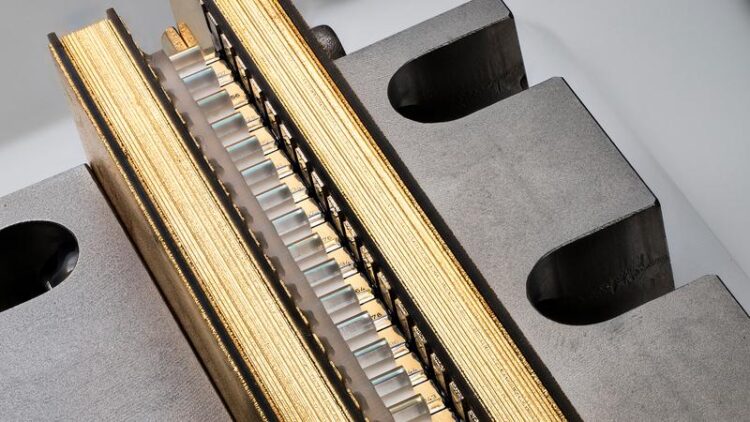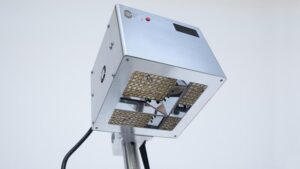New diode laser and UV LED developments at the Photonics Days

Diode laser stack with lenses - as pump laser for industrial applications
(c) Bernhard Schurian / FBH/schurian.com
From October 4 – 7, 2021, the Photonics Days Berlin Brandenburg will be held in hybrid format. The Ferdinand-Braun-Institut, Leibniz-Institut für Höchstfrequenztechnik (FBH) will participate with talks and in the two-day exhibition on October 6-7 in Berlin-Adlershof.
The four-day conference brings together experts from photonics, optics, microsystems technology, and quantum technology. Scientists from the Ferdinand-Braun-Institut will present the latest results on high-power diode lasers, UV LEDs including the corresponding irradiation systems for medical applications, and quantum technologies.
At the booth, FBH will show a diode laser stack optimized for high output powers and a UVC LED irradiation system for medical studies. Moreover, an exhibit exemplifying the application of yellow-green laser modules in ophthalmology will be displayed for the first time. FBH is developing the directly tunable laser sources in the wavelength range from 532 nm to 561 nm to 590 nm with up to 2 watts output power in continuous wave operation. The compact laser sources have the potential to replace significantly larger dye and copper bromide lasers.
LED irradiation systems to fight multidrug-resistant pathogens and coronaviruses

(c) Petra Immerz / FBH
FBH has developed UV LED-based irradiation systems, which are already being tested at the Charité, Universitätsmedizin Berlin and at the Greifswald University Hospital. In the future, this irradiation concept will be used to inactivate multidrug-resistant pathogens such as MRSA and coronaviruses including SARS-CoV-2 directly on humans in a way that does not harm the skin. Each system is equipped with 120 LEDs that emit at 233 nm wavelength, developed jointly with TU Berlin. Thanks to optimized semiconductor epitaxy and chip process technolo-gy, these latest-generation LEDs can be operated with twice the current as before – they de-liver more than 3 mW output power at 200 mA. Furthermore, FBH has developed new silicon-based LED packages in collaboration with the CiS Forschungsinstitut für Mikrosensorik. In addition to efficient heat dissipation, aluminum reflectors and a plano-convex lens ensure a beam angle of only 60 degrees. This, in turn, increases the transmission, i.e. the light that the integrated spectral filter allows to pass through. The systems can irradiate an area of 70 mm diameter with a homogeneity of more than 90 %. The UVC light is free of skin-damaging wavelengths above 240 nm and has an irradiance of 0.4 mW/cm2 – ten times more than that achieved by previous systems.
More details: Session on 7.10. (in presence) “Advanced UV technologies & applications”
Record values for diode lasers – optimized for high output powers
FBH will also present its advances in high repetition rate pump lasers for future high-energy class solid-state laser systems. The institute was able to increase the peak output power of its diode laser bars in quasi-continuous operation by up to four times while maintaining excellent efficiency. This reduces the cost in euros per watt – a key parameter for industry. FBH builds the optimized diode lasers into stack modules, with improvements in packaging and optics. For example, a fiber-coupled pulsed pump laser source with 1 kW output power at 780 nm wavelength was demonstrated for the first time in a 1 mm core fiber (previously 1.9 mm). The passively cooled module was able to increase the duty cycle from 20 % to up to 50 % (10 ms 10…50 Hz).
Weitere Informationen:
https://photonics-days-berlin-brandenburg-2021.b2match.io/agenda – program of Photonics Days
Media Contact
All latest news from the category: Event News
Newest articles

Bringing bio-inspired robots to life
Nebraska researcher Eric Markvicka gets NSF CAREER Award to pursue manufacture of novel materials for soft robotics and stretchable electronics. Engineers are increasingly eager to develop robots that mimic the…

Bella moths use poison to attract mates
Scientists are closer to finding out how. Pyrrolizidine alkaloids are as bitter and toxic as they are hard to pronounce. They’re produced by several different types of plants and are…

AI tool creates ‘synthetic’ images of cells
…for enhanced microscopy analysis. Observing individual cells through microscopes can reveal a range of important cell biological phenomena that frequently play a role in human diseases, but the process of…





















